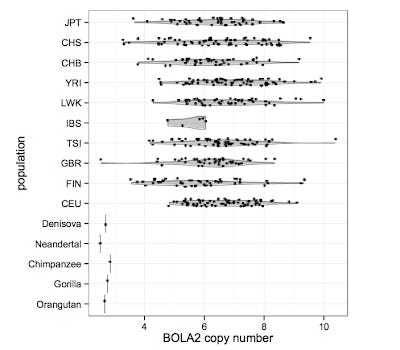Neanderthals dumb?

This figure is from the Supplement (p.62) of a recent Nature paper describing a high quality genome sequence obtained from the toe of a female Neanderthal who lived in the Altai mountains in Siberia. Interestingly, copy number variation at 16p11.2 is one of the structural variants identified in a recent deCODE study as related to IQ depression; see earlier post Structural genomic variants (CNVs) affect cognition.
From the Supplement (p.62):
Of particular interest is the modern human-specific duplication on 16p11.2 which encompasses the BOLA2 gene. This locus is the breakpoint of the 16p11.2 micro-deletion, which results in developmental delay, intellectual disability, and autism5,6. We genotyped the BOLA2 gene in 675 diverse human individuals sequenced to low coverage as part of the 1000 Genome Project Phase I7 to assess the population distribution of copy numbers in homo-sapiens (Figure S8.3). While both the Altai Neandertal and Denisova individual exhibit the ancestral diploid copy number as seen in all the non-human great apes, only a single human individual exhibits this diploid copy number state.
My recollection from the earlier (less precise) Neanderthal sequences is that the number of bp differences between them and us is few per thousand. Whereas, for modern humans it's 1 per thousand with an additional +/-15% variation due to ethnicity. So, I think it's fair to say that they are qualitatively much more different from us than we (moderns) are from each other. See also The genetics of humanness.
My colleague James Lee (I note he is too modest to list his Harvard Law degree on his faculty page!) describes the current era in genomics as an "age of wonder" :-) We can anticipate tremendous discoveries in the next decade.



